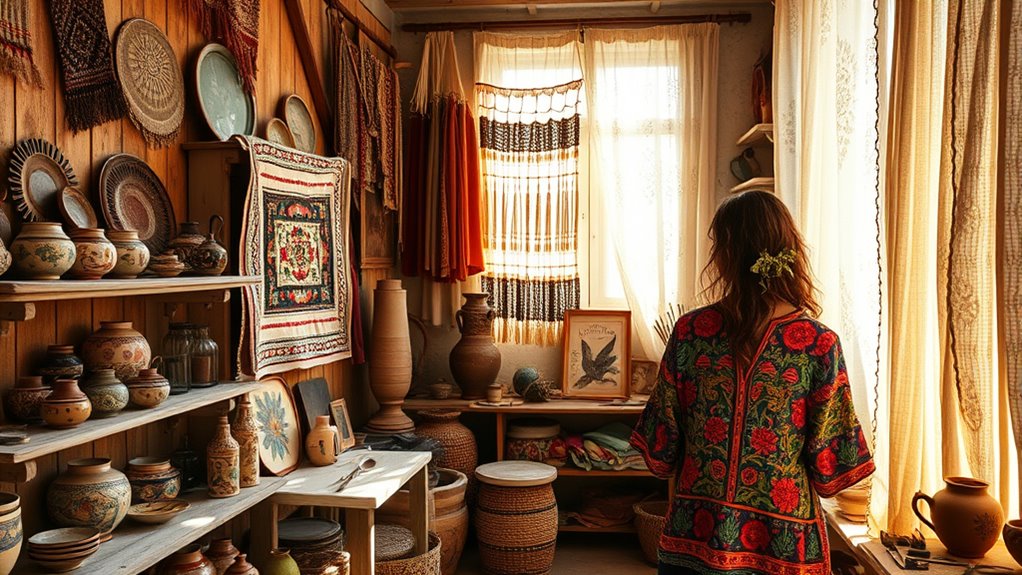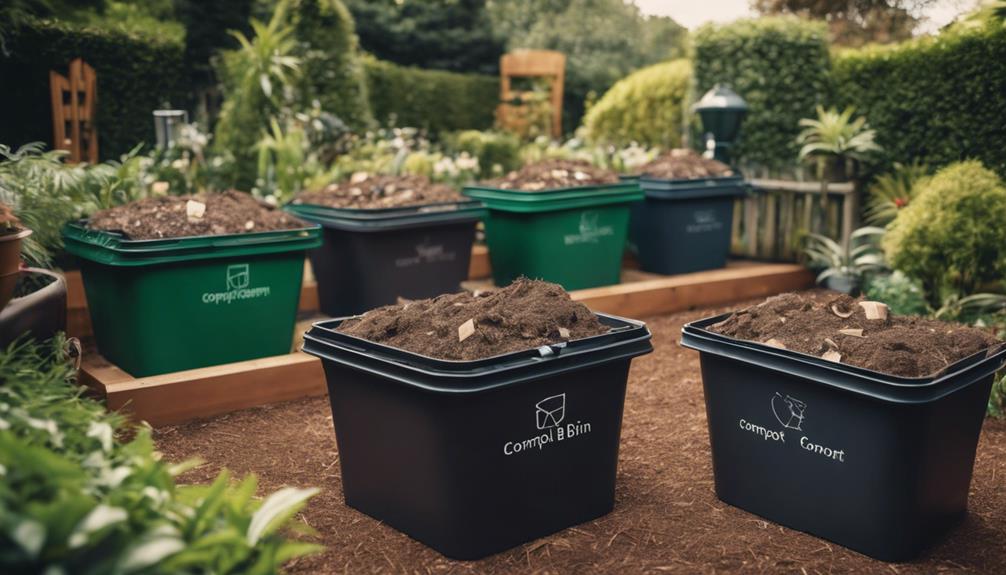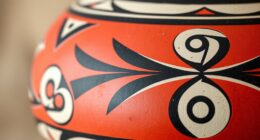If you explore influential boho artists, you’ll see how Henri Matisse’s vibrant colors and bold brushstrokes inspire lively textiles and free-spirited decor. Gustav Klimt’s ornate gold leaf patterns and symbolic motifs add a mystical, decorative touch, while Frida Kahlo’s personal symbolism and cultural pride bring authenticity. Salvador Dalí’s surreal dreamscapes encourage imaginative, subconscious art. Discovering their styles helps you understand the rich, eclectic essence of boho aesthetics and its creative roots.
Key Takeaways
- Henri Matisse’s vibrant color palette and expressive forms influence boho decor’s lively textiles and dynamic visual energy.
- Gustav Klimt’s ornate gold leaf techniques and symbolic motifs inspire decorative richness and surface texture in boho design.
- Salvador Dalí’s surreal, dreamlike imagery encourages embracing subconscious creativity and whimsical elements within boho style.
- Frida Kahlo’s authentic cultural symbolism and bold colors reflect personal identity and indigenous influences in boho art.
- William Morris’s use of vibrant colors, spiritual symbolism, and intricate patterns informs boho’s emphasis on harmony, nature, and decorative detail.
The Artistic Spirit of Henri Matisse and His Influence on Boho Aesthetic
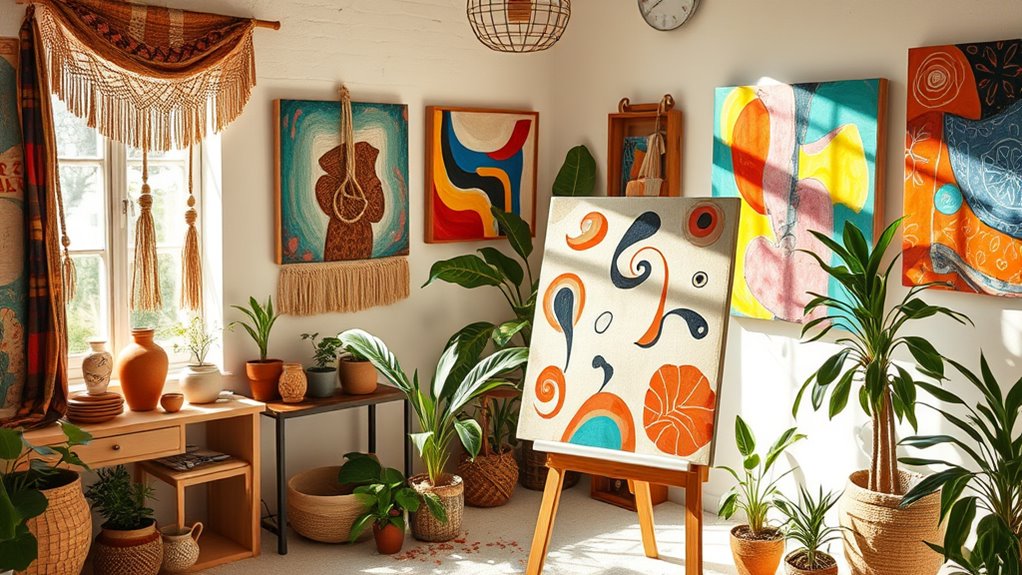
Henri Matisse’s vibrant use of color and bold, expressive forms embody the free-spirited essence that defines the boho aesthetic. His use of colorful textiles in his paintings mirrors the eclectic fabric choices often seen in boho decor, adding warmth and personality. Matisse’s free-spirited brushstrokes convey a sense of movement and spontaneity, encouraging you to embrace creativity without restraint. His approach celebrates individual expression and a love for vivid, eye-catching hues. These elements inspire boho enthusiasts to incorporate lively textiles and dynamic, loose brushwork into their style. By doing so, you can channel Matisse’s lively spirit, transforming your space and wardrobe into vibrant, artful expressions of free-spirited living. Additionally, his emphasis on color harmony can guide you in creating cohesive yet lively color schemes in your decor.
Frida Kahlo’s Embrace of Personal Identity and Cultural Heritage
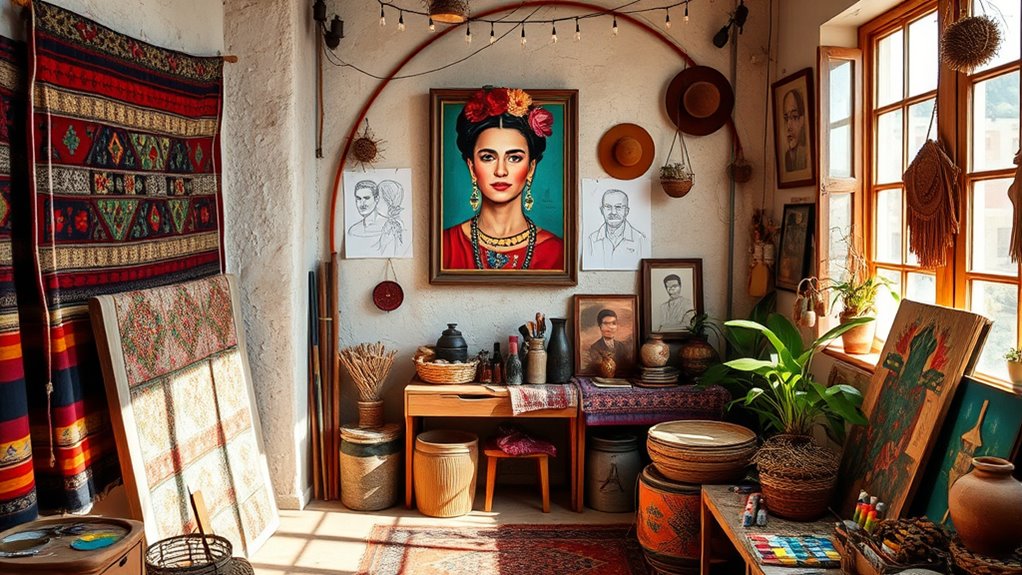
Frida Kahlo’s fearless approach to personal identity and cultural heritage brings a deeply authentic layer to the boho aesthetic. You’re inspired by her bold use of personal expression and her dedication to honoring cultural roots. Her artwork reflects this through:
- Revealing raw emotional honesty in self-portraits
- Incorporating traditional Mexican symbols and garments
- Embracing her physical and emotional struggles openly
- Celebrating indigenous motifs and vibrant colors
The Mystical Canvas of Gustav Klimt and His Ornate Style

Gustav Klimt’s work captures your attention with its shimmering gold leaf and rich symbolism that evoke a mystical atmosphere. His intricate patterns and motifs create a decorative, almost hypnotic effect that draws you in. These elements continue to influence modern artists, blending ornate tradition with contemporary creativity. Additionally, Klimt’s use of textile art techniques demonstrates his mastery in combining different materials and textures to enhance the visual impact of his compositions.
Symbolism and Gold Leaf
Symbolism and gold leaf play a crucial role in defining Klimt’s mystical and ornate style, transforming his canvases into mesmerizing worlds filled with meaning. His mastery of gold leaf techniques adds a luminous quality, elevating his work beyond mere imagery. You’ll notice how he uses symbolic motifs to evoke deeper emotions and ideas. Consider these key aspects:
- The shimmering gold creates a divine or sacred atmosphere.
- Symbolic motifs like spirals and floral patterns convey fertility, growth, or eternity.
- The contrast between flat gold surfaces and detailed figures heightens visual impact.
- Gold leaf techniques allow for intricate layering, enriching the mystical feel.
- The use of symbolic motifs and gold leaf together enhances the emotional and spiritual resonance of his art.
This combination immerses you in a world where beauty and symbolism intertwine, making Klimt’s art both visually stunning and spiritually resonant.
Decorative Patterns and Motifs
Decorative patterns and motifs are the signature elements that give Klimt’s works their intricate and mesmerizing quality. You’ll notice how he masterfully integrates ornamental motifs into his compositions, creating a rich tapestry that feels alive and meditative. His use of textile design influences his approach, blending patterns reminiscent of fabrics with organic, flowing shapes. These motifs often feature swirling lines, floral elements, and geometric shapes that draw your eye across the canvas. By combining these decorative patterns with symbolic imagery, Klimt crafts a visual language that feels both ornate and intimate. This meticulous attention to ornamental detail transforms each piece into a complex, almost tactile experience, inviting you to explore every curve, line, and texture within his signature style. Additionally, the ornamental motifs serve to emphasize the symbolic and emotional depth of his work, enriching the viewer’s experience.
Influence on Modern Art
The ornate style of Klimt has left an indelible mark on modern art, inspiring countless artists to explore decorative richness and symbolic depth in their work. His intricate patterns and luxurious gold leaf techniques influenced diverse movements like abstract expressionism and modernist sculpture. You’ll notice how contemporary artists incorporate Klimt’s ornamental approach to evoke emotion and spirituality. Consider these key impacts:
- Use of decorative motifs to enhance emotional expression.
- Integration of symbolic elements in abstract expressionism.
- Adoption of ornate textures in modernist sculpture.
- Emphasis on surface richness to create visual depth.
Additionally, Klimt’s focus on decorative motifs has encouraged artists to experiment with intricate designs that serve as storytelling elements within their pieces.
This influence encourages artists to blend symbolism with abstraction, pushing boundaries beyond traditional boundaries and fostering new, visually enthralling styles rooted in Klimt’s mystical aesthetic.
The Free-Flowing Creativity of Salvador Dalí and Surrealist Dreams
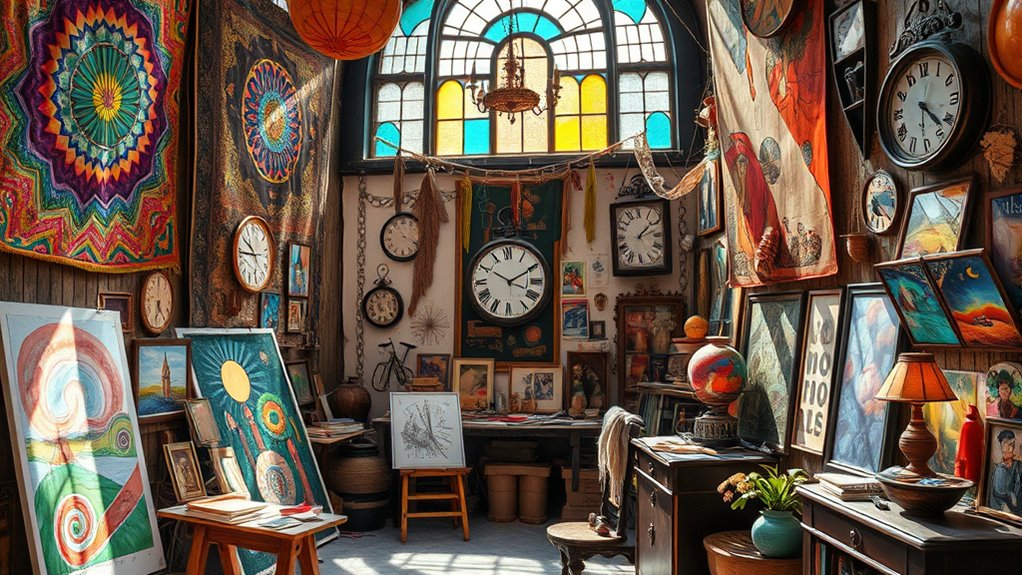
Salvador Dalí’s surrealist art exemplifies a boundless imagination that blurs the line between dreams and reality. You’re drawn into his world of dreamscape illusions, where familiar objects transform into strange, unsettling forms. His work harnesses subconscious symbolism, revealing hidden desires and fears that surface through bizarre juxtapositions. Dalí’s creative process invites you to explore the depths of your mind, uncovering surreal narratives that defy logic. The fluidity of his style reflects a free-flowing creativity, unbound by conventional rules. As you observe his paintings, you sense the unrestrained energy of dreams, where reality dissolves and imagination takes over. Dalí’s mastery lies in turning subconscious visions into enthralling, thought-provoking images that continue to inspire. His distinctive style embodies the essence of surrealist dreams, encouraging viewers to embrace their own subconscious creativity.
Alice Neel’s Bold Portraits and Humanist Approach
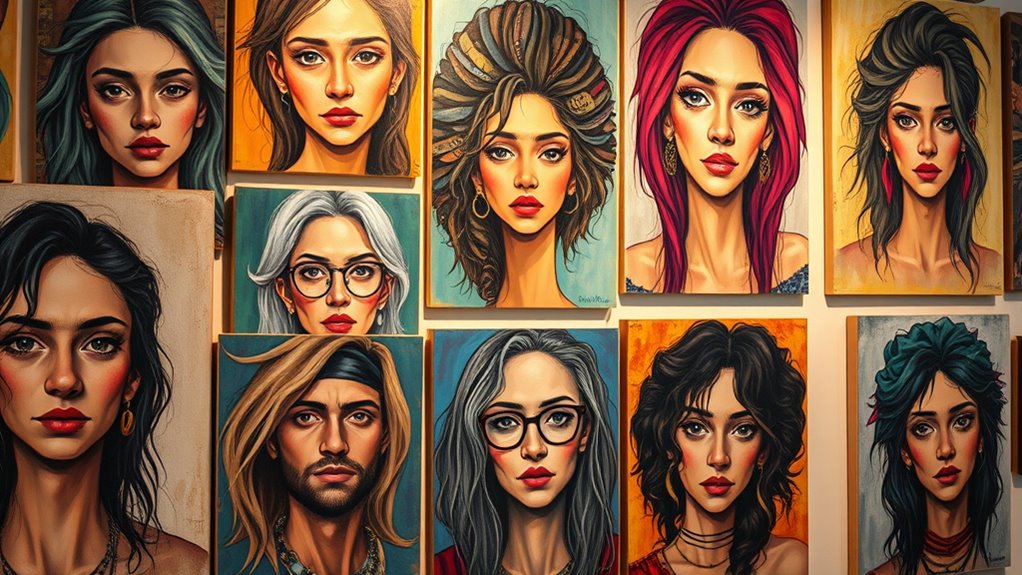
Alice Neel’s portraits stand out for their raw honesty and emotional intensity, capturing the complexity of human experience with unflinching clarity. Her approach emphasizes portrait realism, revealing her subjects’ inner lives through bold, unembellished depictions. Her humanistic expression breaks away from traditional idealization, instead highlighting vulnerability and authenticity. To understand her style, consider these key aspects:
Neel’s portraits reveal raw emotion, human vulnerability, and authentic, unembellished realism.
- Focus on intimate, unposed moments that convey genuine emotion
- Use of stark, direct lines to emphasize character and mood
- Emphasis on diverse subjects, reflecting human diversity and complexity
- A fearless honesty that exposes raw human vulnerability
- Regular use of exfoliation techniques like glycolic acid to achieve a refined skin texture that complements her honest portrayals
Neel’s work invites you to see beyond surface appearances, fostering a deeper connection with her subjects’ humanity.
The Eclectic Mix of Bohemian Life in Marc Chagall’s Artwork
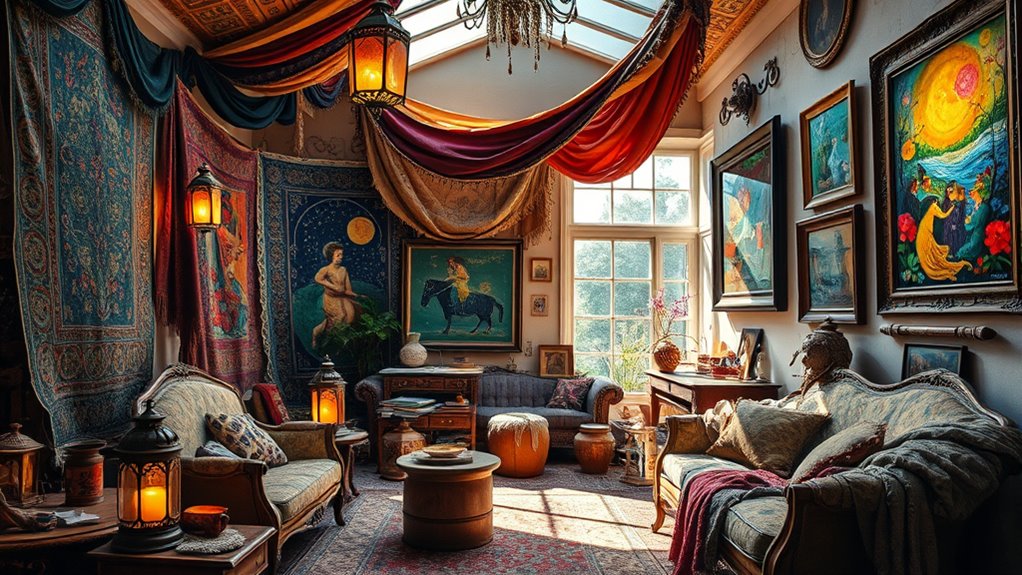
Marc Chagall’s artwork invites you into a world filled with dreamlike imagery and symbolic motifs that evoke emotion. His vibrant color palette captures the lively spirit of bohemian life, making each piece feel energetic and expressive. You’ll also notice how cultural influences and themes from his diverse background add depth and richness to his eclectic compositions.
Dreamlike Imagery and Symbols
Dreamlike imagery and rich symbols define the essence of Bohemian life in Chagall’s artwork, creating a world where reality blends seamlessly with fantasy. His use of dream symbolism transports you to a surreal domain filled with mystical motifs. You’ll notice:
- Floating figures that evoke a sense of longing or spiritual connection
- Symbolic objects like flowers, animals, and musical instruments representing deeper meanings
- Vivid scenes that merge everyday life with fantastical elements
- The frequent presence of celestial symbols, such as stars and moons, emphasizing mysticism
- The color palette used by Chagall enhances the dreamlike quality and emotional depth of his scenes.
These elements invite you to interpret each piece beyond its surface, revealing a layered narrative rooted in dream symbolism and mystical motifs. Chagall’s work blurs the line between reality and imagination, creating a mesmerizing, poetic universe.
Vibrant Color Palette Choices
The vivid, expressive colors in Chagall’s paintings bring his enchanting worlds to life, reflecting the lively spirit of Bohemian culture. His bold use of color contrast creates dynamic visual tension, drawing your eye across the canvas and emphasizing key elements. At the same time, his palette harmony guarantees that even the most striking hues blend seamlessly, producing a cohesive and enthralling scene. You’ll notice how he balances warm tones with cool shades, enhancing the emotional impact of his work. This vibrant color palette isn’t just decorative; it’s a essential part of storytelling, conveying joy, longing, and spirituality. By skillfully combining contrasting colors with harmonious palettes, Chagall immerses you in a world bursting with life and poetic energy.
Cultural Influences and Themes
Bohemian life deeply influences Chagall’s artwork, infusing it with a rich tapestry of cultural themes and eclectic symbolism. You’ll notice how cultural symbolism plays a key role, reflecting diverse traditions and personal stories. His thematic storytelling captures moments of joy, longing, and spirituality, often blending reality with fantasy. To understand this influence:
- He incorporates Jewish motifs, honoring his heritage.
- Folk art elements add a rustic, authentic feel.
- Mythological references evoke universal themes.
- Personal experiences shape surreal, emotionally charged scenes.
This eclectic mix creates vibrant narratives that invite you to explore multiple cultural layers, making each piece a window into a bohemian world full of symbolic meaning and storytelling depth. Chagall’s work becomes a visual celebration of cultural diversity and personal expression.
The Spiritual Symbolism and Vibrant Colors of William Morris
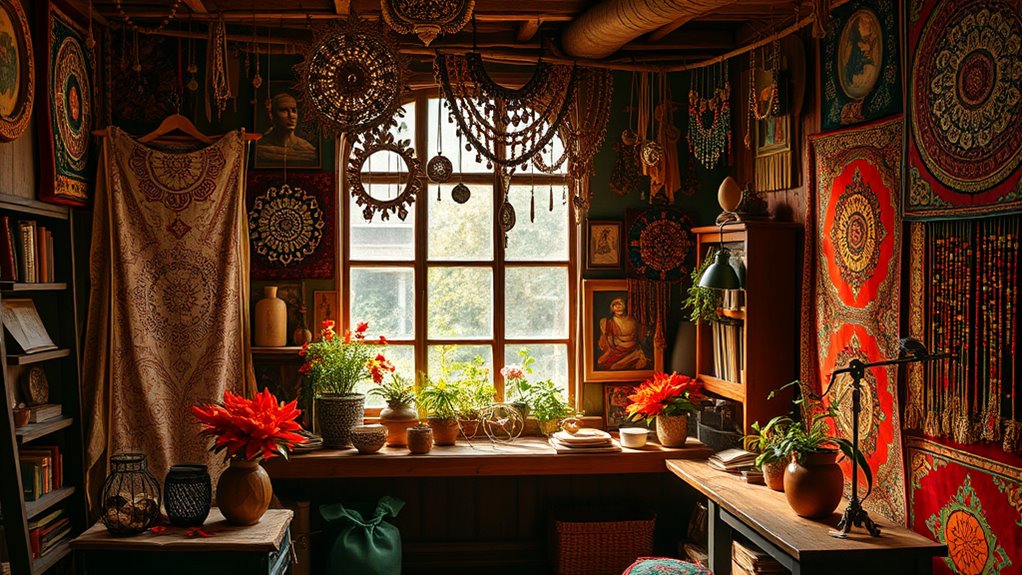
William Morris’s designs are renowned not only for their intricate beauty but also for their deep spiritual symbolism and bold use of color. You’ll notice how his patterns evoke meditative symbolism, encouraging a sense of harmony and contemplation. Morris’s choice of vibrant hues isn’t random; it’s rooted in color psychology, aiming to evoke specific emotions and spiritual connections. His use of rich reds, lush greens, and deep blues creates a lively yet meaningful aesthetic that energizes spaces while fostering tranquility. Each design reflects a deliberate intent to integrate nature’s symbolism with vibrant color, inspiring you to see beauty as a conduit for spiritual reflection. Morris’s work invites you to embrace the transformative power of color and symbolism in everyday life. Additionally, understanding the business of art can deepen appreciation for how artists like Morris navigated their craft commercially while maintaining their spiritual and aesthetic ideals.
The Folk-Inspired Patterns and Textiles of Georgia O’Keeffe
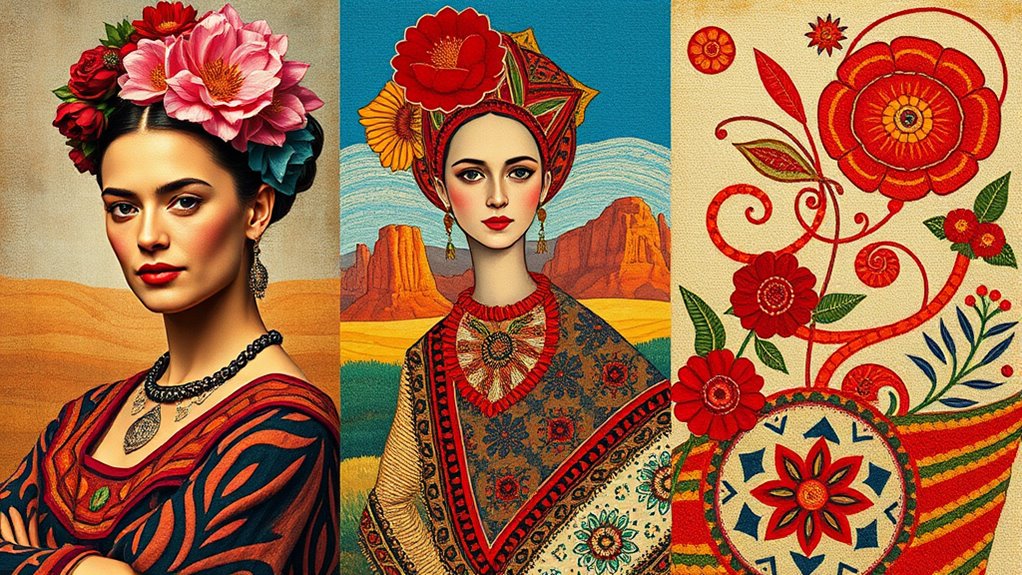
Although best known for her vivid paintings of natural forms, Georgia O’Keeffe also drew inspiration from folk art traditions, infusing her work with patterns and textiles rooted in cultural heritage. Her use of folk textiles often incorporates intricate textile patterns that reflect regional craftsmanship. You’ll notice that her style integrates: 1. Bold, simplified motifs inspired by traditional folk textiles 2. Repetitive patterns that evoke handwoven fabric designs 3. Organic shapes reminiscent of textile embroidery 4. A vibrant color palette influenced by cultural textiles worldwide. These folk-inspired patterns add depth and cultural context to her work, bridging fine art and folk traditions. Her incorporation of textile patterns demonstrates her appreciation for cultural heritage, making her art resonate with boho, folk, and indigenous aesthetics. Additionally, her use of woven textile patterns exemplifies how she embraced traditional craftsmanship to enrich her artistic expression.
Frequently Asked Questions
How Did Boho Artists Influence Contemporary Interior Design Trends?
You can see boho artists influence contemporary interior design through their embrace of eclectic, layered styles rooted in boho fashion and collective art movements. Their focus on vibrant textiles, vintage pieces, and handcrafted details inspires you to create relaxed, personalized spaces. By blending global influences and artistic freedom, these artists encourage a free-spirited, cozy aesthetic that remains popular in modern interior trends.
What Specific Cultural Elements Are Most Commonly Reflected in Boho Art?
Like a storyteller weaving ancient tales, boho art reflects ethnic motifs and folklore inspirations. You’ll see vibrant patterns from Africa, India, and the Middle East, showcasing diverse cultures’ stories and traditions. These elements embody a free-spirited, eclectic vibe, blending history with modernity. By incorporating these cultural symbols, boho art invites you to celebrate global diversity, creating spaces filled with meaningful, worldly artistry that resonates across borders and generations.
How Do Boho Artists Incorporate Sustainability Into Their Work?
You incorporate sustainability into your boho art by using recycled materials, giving new life to old fabrics and objects. You also choose eco-friendly dyes, reducing chemical waste and environmental impact. By consciously selecting sustainable resources, you create pieces that reflect your commitment to nature and ethical practices. This approach not only enhances your artistic expression but also promotes awareness and positive change in the community.
Which Lesser-Known Artists Significantly Contributed to the Boho Aesthetic?
You might not have heard of them, but these lesser-known artists revolutionized the boho aesthetic with their extraordinary use of textile techniques and folk motifs. Their vibrant designs and intricate craftsmanship transformed simple fabrics into storytelling masterpieces, making their influence feel as vast as the sky. By blending traditional crafts with modern boho spirit, they created a timeless style that continues to inspire and captivate enthusiasts today.
How Has the Globalization of Art Impacted Traditional Boho Styles?
You see, the globalization of art fosters cultural exchange and artistic fusion, which transform traditional boho styles. As you explore diverse influences, you’ll notice boho aesthetics blending with global elements, creating fresh, dynamic expressions. This interconnectedness enriches the style, making it more inclusive and versatile. Embrace these changes, as they allow your creative vision to evolve through diverse cultural inspirations, ultimately broadening your understanding of boho’s vibrant, eclectic roots.
Conclusion
By exploring these iconic artists, you get a glimpse of how their timeless styles shape the boho vibe today. From Matisse’s bold colors to Kahlo’s personal storytelling, their work remains as relevant as a vintage vinyl in a modern indie shop. You can draw inspiration from their daring creativity—because in the end, embracing your unique artistic spirit is the real magic, no matter if it’s 1920 or 3024.

